
March 10, 2008
Remembering "Uncle Fred"
TOWER SITE CALENDAR 2008 - NOW AVAILABLE!!!
TUESDAY UPDATE: The
Citadel budget cutbacks have claimed local sports radio in RHODE
ISLAND. The struggling broadcast company pulled the plug
this morning on "The Score" (WSKO 790 Providence/WSKO-FM
99.7 Wakefield-Peace Dale), replacing it with satellite-fed True
Oldies Channel on the AM side and with an FM simulcast of news-talk
WPRO (630).
Since there's already a WPRO-FM (Citadel's top 40 station
on 92.3), the move presents a bit of a branding issue, being
resolved for now by calling the news-talk simulcast simply "630
WPRO & 99.7." Don Imus' morning show remains in place
on the 790 AM signal, and we're hearing the venerable WEAN calls
may be resurrected there. (Right now, 790 is using new calls
WPRV; we suspect those calls may actually be destined for 99.7
when the changeover is complete.)
Fans of Opie & Anthony, who had been heard on 99.7, will
have to try to pick them up from Boston's WBCN; fans of the Jim
Rome show are out of luck for now - and as for the Yankees, who'd
been a WSKO staple, we don't know yet.
Much more in next Monday's NERW...
*It's rare that we start the column with
an obituary, but in his 56 years, Fred Horton touched so many
radio people in his native upstate NEW YORK and beyond
that it seems only fitting he lead off this week's issue.
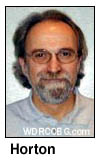 Horton
grew up in Syracuse and began his radio career there, as one
of the many jocks to pass through the doors of WOLF, then across
town at WNDR. After that, his travels took him all across upstate
New York, including stints at WAAL in Binghamton, WRUN/WKGW in
Utica, WGNA/WPYX/WTRY in Albany (where he's credited with making
WGNA's country format into a major player), WSEN and WYYY back
in Syracuse, WCMF in Rochester, and some time as a record promoter
in Buffalo. Horton
grew up in Syracuse and began his radio career there, as one
of the many jocks to pass through the doors of WOLF, then across
town at WNDR. After that, his travels took him all across upstate
New York, including stints at WAAL in Binghamton, WRUN/WKGW in
Utica, WGNA/WPYX/WTRY in Albany (where he's credited with making
WGNA's country format into a major player), WSEN and WYYY back
in Syracuse, WCMF in Rochester, and some time as a record promoter
in Buffalo.
In 1993, Horton became PD of New York's country WYNY (103.5),
scoring the station its highest ratings in that format before
its flip to WKTU.
Horton also worked in Connecticut, as PD/station manager at
WDRC, in Grand Rapids at WGRD, and in Memphis at WGKX.
More recently, he worked in Rochester as morning man and PD
at WBEE-FM (92.5) in the late nineties, moving to Erie, PA in
2001 to be morning man (and eventually operations manager) at
WXTA (97.9 Edinboro), a job he held until just last year.
"Uncle" Fred was a radio guy to the core, as his
colleague Cary Pall fondly remembers in
a posting on his blog, and remained passionate about the
medium even in the last days of his fight against cancer, which
claimed his life last Tuesday (March 4).
Funeral services for Horton will be held March 15 at 1 PM
at Calvary Chapel in Liverpool; he's survived by his mother,
two daughters, six grandchildren and numerous nieces and nephews
- and by a region full of radio people who were lucky enough
to have worked for him, or even to have listened to him along
his journey.
*New York's mayor is looking for a new radio home. Michael
Bloomberg had a regular weekly appointment with John R. Gambling
at WABC (770), but with Gambling's recent departure from the
station in a flurry of budget cuts, the mayor is looking around
for another slot. Will Gambling's WABC replacement, Curtis Sliwa,
get the nod? Or will the mayor look to rival talk stations, perhaps
WOR or WNYC? (One unlikely possibility is Bloomberg Radio's WBBR
1130; the mayor has maintained a hands-off stance toward his
own media properties since taking office.)
Up the dial at WWRL (1600 New York), we're hearing that morning
host Richard Bey is out after less than five months. The morning
slot at the progressive talker has been notoriously unstable
of late; Bey and Mark Riley took over from Armstrong Williams
and Sam Greenfield last October, and Riley was replaced by Coz
Carson in January.
The city's newest "radio" station, "Pulse 87,"
WNYZ-LP (Channel 6, aka 87.7 FM) is adding airstaff. The dance
station brings Jimmy "Showboat" Fields, late of WKTU,
aboard for evenings, while former WCAA (La Kalle 105.9) jock
Laura Stylez joins for weekends.
 Upstate, Ticonderoga's
WIPS (1250) went silent at noon on Feb. 29, and it won't be returning
to the air, at least not under current owner BisiBlue LLC. The
company, a division of Crown Point Network Technologies, tells
the Plattsburgh Press Republican that ad revenue never
developed in the seven years it owned the station, and that it
was sustaining losses of $3,000 a month at the end to keep the
1 kW daytimer on the air. Upstate, Ticonderoga's
WIPS (1250) went silent at noon on Feb. 29, and it won't be returning
to the air, at least not under current owner BisiBlue LLC. The
company, a division of Crown Point Network Technologies, tells
the Plattsburgh Press Republican that ad revenue never
developed in the seven years it owned the station, and that it
was sustaining losses of $3,000 a month at the end to keep the
1 kW daytimer on the air.
It's been less than a year since WCFE (Channel 57) in Plattsburgh
lost its Lyon Mountain transmission tower to an April ice storm,
and just a few months since the station made it back on the air
from a rebuilt tower - and now "Mountain Lake PBS"
is off the air again. Blame a tower crew that was trying to get
to the top of the new tower to change a beacon light - a crew
member dislodged a chunk of ice that hit the transmission line
as it was falling, denting it beyond usability. WCFE-DT (Channel
38) is back on the air from a lower standby antenna, and the
station hopes to be back on the air with its analog signal sometime
today.
Down the road in Albany, WXXA (Channel 23) has lost its news
director of four years. Gene Ross is headed south to sister Clear
Channel (for now) TV stations WTEV/WAWS in Jacksonville, Florida,
where he'll serve as news director at that CBS/Fox pair of stations.
On the radio side of things in Albany, the new owners at WGDJ
(1300 Rensselaer) are applying for more power. The talk station
currently runs 5 kilowatts day and night, with four towers by
day and a very directional six-tower pattern at night. It can't
do much about the pattern, but WGDJ has applied to boost power
to 10 kW days, 8 kW at night from its existing array south of
Albany.
In Syracuse, Ed Levine's Galaxy Communications has been granted
a construction permit for a slight power increase at WZUN (102.1
Phoenix). "Sunny 102" stays put at its existing tower
site in Warners, right where I-690 meets the Thruway, and it
stays put at its existing 6 kW power level, but it will raise
its antenna from 265' to 312' above average terrain.
Entercom is moving airstaff around at its Rochester cluster:
starting Wednesday, Brian Robinson will move his afternoon show
from classic hits WBZA (98.9 the Buzz) to classic rock WCMF (96.5).
That's the shift formerly occupied by Big Marc, who's now part
of the CMF morning show.
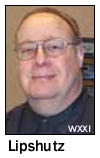 On
the public radio front, Mordecai Lipshutz is retiring from Rochester's
WXXI-FM (91.5) after 32 years with the station, most of them
as its afternoon host. No replacement has been named yet. On
the public radio front, Mordecai Lipshutz is retiring from Rochester's
WXXI-FM (91.5) after 32 years with the station, most of them
as its afternoon host. No replacement has been named yet.
Down the Thruway in Buffalo, Gabe DiMaio is changing public
radio stations: he's moving from WBFO (88.7), where he was operations
manager and local host of All Things Considered, to WNED-FM
(94.5), where he'll serve as program director of the classical
station.
Last Monday came and went without a new format at WECK (1230
Cheektowaga). The station's change of ownership, from Regent
to Dick Greene, was apparently held up slightly - but Greene
and his new PD, Tom Schuh, promise a "soft launch"
of their new talk/sports format on WECK this Wednesday, if all
goes well. (The new WECK has added another host, too: Brad Riter
will be talking sports from 6-9 PM weeknights.)
Another Buffalo radio veteran has resurfaced in the Memphis
market: Tony Magoo is now handling middays on "Rebel Country"
WVIM (95.3 Coldwater MS.)
Here's a call change nobody's likely to notice: WMJQ (1330
Ontario) has changed calls to WYNY. The as-yet-unbuilt construction
permit east of Rochester traded its calls with those of a station
on 1240 in Cross City, Florida, west of Gainesville.
Moving south, there's a new translator on the air in Geneva.
W239BJ (95.7) signed on last week, relaying public broadcaster
WRVO (89.9 Oswego) - not an easy feat, with rival public station
WEOS (89.7 Geneva) just down the dial.
And there's another New York obituary to report as well: Ronnie
Italiano was better known as "Ronnie I" on a series
of Big Apple outlets that included WHBI (105.9 Newark, now WCAA),
its successor WNWK and later WNYE (91.5), where he kept the torch
burning for doo-wop music. As founder of the organization United
in Group Harmony, he was one of the protesters when WCBS-FM dropped
doo-wop music (and then its oldies format entirely) a few years
ago. Italiano died last Monday (Mar. 3) after a long fight with
liver cancer.
|
GETCHER 2008 TOWER SITE CALENDAR
- BEFORE THEY'RE ALL GONE!
Still haven't ordered your 2008 Tower Site Calendar?
You do realize that it's now...er...2008, don't you? We're already
down to the last 80 or so calendars, and they're going
fast. The 2006 and 2007 editions of the calendar sold out, and
this one will do so as well, possibly as soon as this month.
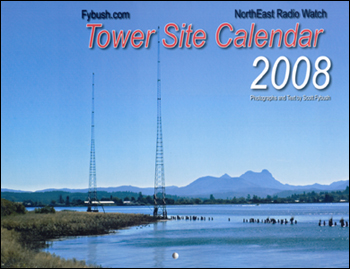
This year's edition is a particularly
fine one, if we do say so ourselves. From the cover photo of
KAST in Astoria, Oregon to the back cover shot of the Blaw-Knox
diamond tower at WBNS in Columbus, this year's calendar features
14 all-new full-color shots of famous broadcast sites far and
wide. There's KROQ in Los Angeles, KFBK in Sacramento, WESX in
Salem, WGAN in Portland, Black Mountain in Vegas, Mount Spokane
in Spokane, and many (ok, several) more.
The calendar is just $18 with
shipping and handling included - or better yet, beat our move
to mandatory subscriptions later this year and get a free calendar
with your $60 subscription to NERW for 2008. (Remember, the proceeds
from both the calendar and the subscriptions help keep NERW right
here on the web, as we head into our fourteenth year of news
and analysis.)
So click
right here and you can be sure to have your very
own Tower Site Calendar 2008! (And thank you!)
The 2008 Tower
Site Calendar is dedicated to the memory of Robert Eiselen (1934-2007),
whose digital imaging skills made even a bunch of pictures of
radio towers look almost like art. His contributions were essential
to the calendar's evolution from 2003 to the current edition,
and he will be missed dearly. |
*In MASSACHUSETTS, Glenn Ordway is
off the air at WEEI (850 Boston) while he deals with a family
crisis. Ordway's wife, Sarah, gave birth to a baby girl, Mia
Grace Ordway, on Feb. 28, but both mother and baby suffered injuries
during the delivery. The baby is in intensive care at Children's
Hospital, and Ordway, very understandably, is focusing his energies
on his family rather than on the station.
"By nurturing Sarah back to health quickly, I believe
that we can allow the mother and baby bonding process to happen
and subsequently increase baby Mia’s chances for a recovery,"
Ordway said in a statement released by the station.
Guest hosts are handling Ordway's duties on the air, and the
"Whiney Awards" ceremonies scheduled for Tuesday have
been postponed until April 3.
In happier WEEI news, "Dale and Holley" co-host
Michael Holley has signed what the station calls a "new
multi-year contract" that will keep him in place on the
sports station's 10 AM-2 PM shift.
Down the hall at talker WRKO (680), executive producer Tom
Shattuck has given his notice. He's reportedly jumping ship to
rival talk station WTKK (96.9), and he's said to be quite unhappy
over WRKO's treatment of his friend Moe Lauzier, who was ousted
from his Saturday shift after a quarter-century.
 Over
at Boston's other sports station, WAMG (890 Dedham)/WLLH (1400
Lowell), the last thing they needed was more bad publicity -
but that's what "ESPN 890" got last week, after David
Scott's "Scott's Shots" column at Boston
Sports Media Watch exposed the misuse of football tickets
that had been donated to the station for use at a charity event.
Scott reports that two of the Pats-Giants tickets, donated by
the Giants organization, were indeed sold at a charity auction
last summer - but that WAMG general manager Jessamy Tang kept
the other pair of tickets for use as a station giveaway. A WAMG
lawyer tells Scott that the giveaway was a "mistake,"
and that better controls will be put into place to make sure
it doesn't happen again. Over
at Boston's other sports station, WAMG (890 Dedham)/WLLH (1400
Lowell), the last thing they needed was more bad publicity -
but that's what "ESPN 890" got last week, after David
Scott's "Scott's Shots" column at Boston
Sports Media Watch exposed the misuse of football tickets
that had been donated to the station for use at a charity event.
Scott reports that two of the Pats-Giants tickets, donated by
the Giants organization, were indeed sold at a charity auction
last summer - but that WAMG general manager Jessamy Tang kept
the other pair of tickets for use as a station giveaway. A WAMG
lawyer tells Scott that the giveaway was a "mistake,"
and that better controls will be put into place to make sure
it doesn't happen again.
In Fall River, Mike Moran has departed WSAR (1480), where
he co-hosted from 6-9 AM with Hec Gauthier, then had an hourlong
talk show of his own.
And at Worcester's WCRN (830), Telegram & Gazette columnist
Diane Williamson is joining the roster of talk hosts. Williamson
will be learning on the job, co-hosting the 1-2 PM hour with
Hank Stolz on Tuesdays and Thursdays before taking over the slot
five days a week sometime soon.
*There's a frequency flip coming in southeastern
CONNECTICUT, though one of the stations involved actually
transmits from RHODE ISLAND and the other from Long Island.
 On
March 18, Citadel will swap facilities between talker WXLM (102.3
Stonington CT) and classic rock "Wolf" WMOS (104.7
Montauk NY). The idea is to improve the reach of the Wolf, which
broadcasts from studios at the Mohegan Sun casino but has trouble
being heard in much of the region because of a signal that sometimes
doesn't make it across Long Island Sound very well. Moving the
Wolf to 102.3, with a transmitter site just north of Westerly,
will solve that problem; the talk format on WXLM, meanwhile,
will run in mono when in moves to 104.7, which should make the
weaker signal more tolerable. On
March 18, Citadel will swap facilities between talker WXLM (102.3
Stonington CT) and classic rock "Wolf" WMOS (104.7
Montauk NY). The idea is to improve the reach of the Wolf, which
broadcasts from studios at the Mohegan Sun casino but has trouble
being heard in much of the region because of a signal that sometimes
doesn't make it across Long Island Sound very well. Moving the
Wolf to 102.3, with a transmitter site just north of Westerly,
will solve that problem; the talk format on WXLM, meanwhile,
will run in mono when in moves to 104.7, which should make the
weaker signal more tolerable.
*In other Ocean State news, WRNI (1290 Providence/102.7 Narragansett
Pier) is adding to its news staff. Veteran WHJJ (920) news director
John Carpilio, who's most recently been with Metro Networks,
joins WRNI as news/program director. He replaces Mark Degon,
who becomes managing editor at former WRNI parent WBUR in Boston.
WRNI-FM is hoping to improve its signal; it's applying for
a power increase from 1950 watts to 6 kW, adding a directional
antenna to avoid new interference with WXLM and Boston-area WKLB
(102.5 Waltham).
*Several weekend specialty shows are history
at VERMONT's "Point" stations, WNCS (104.7 Montpelier)/WRJT
(103.1 Royalton)/WDOT (95.7 Danville), as George Thomas' "Global
Jam" and Lou D'Antonio's "Jazz Spectrum" have
given way to more of the station's regular AAA format on Sunday
nights.

You can have
your ad here! Click
here
for information on the most economical way to reach tens of thousands
of Northeast radio and TV people each week. |
*Radio people on the move in NEW JERSEY:
At the Access.1 cluster in Atlantic City (WMGM/WTKU/WJSE),
Nick Giorno is out as director of programming, replaced by former
WYSP (94.1 Philadelphia) production director Rich DeSisto. DeSisto
also takes afternoon drive on WMGM (103.7 the Shark), while Scott
Reilly becomes assistant PD and afternoon jock on WJSE (102.7),
replacing Shawn Castelluccio.
We're also hearing about budget cuts at Access.1's TV operation,
WMGM-TV (Channel 40), which has apparently shut off its main
analog transmitter and is operating with its backup unit at just
1 kW ERP until the demise of analog TV in less than a year.
At the other end of the state, WRNJ (1510 Hackettstown) has
begun relaying its programming over two FM translators. W284AQ
(104.7 Hackettstown) and W224AS (92.7 Washington) had been rebroadcasting
WBGO (88.3 Newark) until the FCC granted special temporary authority
to relay the AM daytimer instead.
*It was a quiet week in PENNSYLVANIA,
but there's at least one new signal on the way. WGLD (1440 Red
Lion) will complete its move to Manchester Township, near York,
by the end of March. Operating from the WSBA (910 York) transmitter
site, it appears the new WGLD may be a sports station - it's
signed on to the Phillies' radio network for the 2008 season.
(Yes, we'll have the annual NERW "baseball on the radio"
list coming in the March 24 issue.)
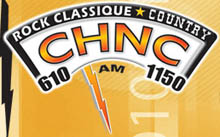 *Lots
of news to report from CANADA this week, beginning with
the grant of a big AM-to-FM move on Quebec's Gaspe Peninsula. *Lots
of news to report from CANADA this week, beginning with
the grant of a big AM-to-FM move on Quebec's Gaspe Peninsula.
CHNC (610 New Carlisle) and CHGM (1150 Gaspe) will trade their
AM signals for a network of five FM facilities: 107.1 in New
Carlisle, with 6 kW DA/169 m; 99.3 in Gaspe, with 468 watts DA/73
m; and relays on 99.1 in Carleton, 98.3 in Chandler and 107.3
in Perce.
Another Gaspe Peninsula application was denied: Radio du Golfe
won't be allowed to put new signals on the air at 92.7 in Gaspe
and Riviere au Renard.
In Montreal, CHOU (1450) wants more power. The ethnic station
signed on last year with 1 kW full-time, but it tells the CRTC
it needs to double that to 2 kW to fully serve its market.
There's a format change in southwestern Ontario: CFCO (630
Chatham-Kent) dropped its longtime oldies format last Monday,
becoming "Country 92.9," branding itself with the frequency
of its low-power FM relay instead of its wide-coverage AM outlet.
Sister station CKSY (94.3) has rebranded as "Lite Hits 94.3."
It's not the only country station in the neighborhood, either:
in Leamington, CJSP (92.7) signed on Monday with country.
Over in Kingston, UCB Canada has been granted a 50-watt relay
on 100.5 for its CKJJ (102.3 Belleville).
 In Nova Scotia,
Wayne Harrett's Seaside FM (CFEP 94.7 Eastern Passage) has been
dealt a setback in its attempt to raise power from its current
50 watts to 1.4 kW. While the station received CRTC approval
for the power increase back in November, it hit an objection
from MBS Radio, which says the increased power at CFEP could
cause interference to its CKWM (94.9 Kentville). Despite an offer
from Harrett to increase the power at CFEP in steps, allowing
MBS to gauge whether or not actual interference to CKWM would
result, the two sides couldn't come to an agreement - and now
Seaside FM will apparently have to look for a new frequency for
its power increase, at a cost of at least C$10,000 to the volunteer
operation. In Nova Scotia,
Wayne Harrett's Seaside FM (CFEP 94.7 Eastern Passage) has been
dealt a setback in its attempt to raise power from its current
50 watts to 1.4 kW. While the station received CRTC approval
for the power increase back in November, it hit an objection
from MBS Radio, which says the increased power at CFEP could
cause interference to its CKWM (94.9 Kentville). Despite an offer
from Harrett to increase the power at CFEP in steps, allowing
MBS to gauge whether or not actual interference to CKWM would
result, the two sides couldn't come to an agreement - and now
Seaside FM will apparently have to look for a new frequency for
its power increase, at a cost of at least C$10,000 to the volunteer
operation.
A veteran Montreal radio newsman has retired. Frank McCormick
came to CKGM-FM (97.7, now CHOM) in the 1960s, and moved to the
CBC in the 1980s. McCormick delivered his last newscast for CBC
Montreal on Feb. 29.
*And we close out this week with a new feature we're calling
the NERW Bookshelf, reviewing books our readers
might find of interest.
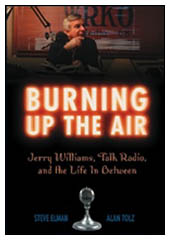 Jerry
Williams defined talk radio in Boston for decades, and his promos
at WRKO touted him as "The Dean of Talk Radio." But
as his former producers Steve Elman and Alan Tolz recount in
their new book, Burning Up the Air: Jerry Williams, Talk Radio
and the Life In Between (Commonwealth Editions), Williams'
contributions to the field were actually even deeper; indeed,
his now largely forgotten early career at stations such as WKDN
in Camden, New Jersey, WIBG in Philadelphia and WMEX in Boston
qualifies him as an inventor of the format. Jerry
Williams defined talk radio in Boston for decades, and his promos
at WRKO touted him as "The Dean of Talk Radio." But
as his former producers Steve Elman and Alan Tolz recount in
their new book, Burning Up the Air: Jerry Williams, Talk Radio
and the Life In Between (Commonwealth Editions), Williams'
contributions to the field were actually even deeper; indeed,
his now largely forgotten early career at stations such as WKDN
in Camden, New Jersey, WIBG in Philadelphia and WMEX in Boston
qualifies him as an inventor of the format.
In this compulsively readable volume, Elman and Tolz dig deeply
into Williams' personal life, tracing his difficult childhood
in Brooklyn and his oft-exaggerated earliest days in radio at
WCYB in Bristol, Virginia, WEDO and WLOA in Pittsburgh and WKAP
in Allentown. They also paint a colorful picture of skinflint
WMEX owner Mac Richmond ("one of the legendary whack jobs
of broadcasting") and the technical challenges of live talk
radio in the late fifties, when Williams broadcast his late-night
show in front of a live audience at the WMEX studios at Brookline
Avenue, a time when anyone could - and did - wander in from the
streets.
The book follows Williams away from Boston to his successes
in Chicago at WBBM, then through his return to Boston to even
greater acclaim at WBZ, the challenges that followed his 1976
break with that station, and his triumphant return to the Boston
airwaves as the signature voice of "The Talk Station,"
WRKO, beginning in 1981.
The authors do a masterful job of capturing Williams' voice
in print, aided by a sizable collection of vintage airchecks
(many of them available for listening at the companion website,
jerrywilliams.org.)
They're also assisted by reams of paperwork, much of it rescued
by the authors from Williams' South Shore barn.
At the same time, Elman and Tolz don't try to sugarcoat Williams'
rocky personal life, chronicling in detail his marriages and
his affairs over the decades. They also paint a painful picture
of his later years, as repeated station sales and management
changes and the rise of newcomers like Howie Carr diminished
Williams' influence at WRKO and as illness took its toll on the
aging talk host.
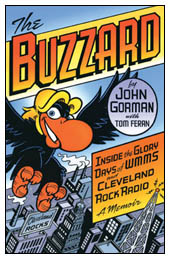 Another
recent radio-related book, John Gorman's The Buzzard: Inside
the Glory Days of WMMS and Cleveland Rock Radio (Gray &
Co.), wouldn't seem to be NERW-related at first (unless you count
WMMS' fringe signal into a few corners of northwestern Pennsylvania),
but it turns out that the legendary rocker from the "North
Coast of America" had some deep roots in Boston, of all
places. Another
recent radio-related book, John Gorman's The Buzzard: Inside
the Glory Days of WMMS and Cleveland Rock Radio (Gray &
Co.), wouldn't seem to be NERW-related at first (unless you count
WMMS' fringe signal into a few corners of northwestern Pennsylvania),
but it turns out that the legendary rocker from the "North
Coast of America" had some deep roots in Boston, of all
places.
Gorman, who served as WMMS program director from 1973-1986,
is a native of South Boston who got his start in Boston radio
at WORL, WHDH-FM and the early WNTN - and early on, he drew heavily
on the Boston scene for the talents who turned WMMS into one
of the most respected FM stations in America. At times, the station
was home not only to Denny Sanders, another veteran of WNTN and
MIT's WTBS, but also to music director Donna Halper, morning
jock Debbie Ullmann, and later to WVBF alumni Charlie Kendall
in mornings and "BLF Bash" in overnights.
But there's much more to this book than its colorful descriptions
of these Boston personalities (even if we do learn more from
Gorman about Halper's Canadian connections that led to her discovery
of the band Rush.)
Just as Burning Up the Air is a story not just of Jerry
Williams but of the birth of talk radio in general, The Buzzard
is a time capsule of an era when FM rock stations were emerging
from the underground and becoming big business. The stories Gorman
tells - of the sneaky ways WMMS obtained preview copies of new
releases and evaded record company cease and desist orders, of
the battles between station staffers and corporate management,
and most of all of the promotional and programming wars between
WMMS and the many stations that tried (never with any great success)
to knock it off its perch.
And just as the Williams book comes to something less than
a happy ending, as the fading master of talk tries to recapture
his magic at ever-smaller stations up the dial, so does Gorman's
book end in the only real way possible, with new management tampering
with the formula that kept WMMS successful even as its music
mix kept changing. That formula, as Gorman defines it, was to
make WMMS not a rock station or a top 40 station, but a "popular
culture" station, programmed with full-service elements
such as traffic and business reports along with music that crossed
genre and format lines.
While Gorman's book closes in 1986 with his departure from
WMMS (he'd return a decade later for a short stint under new
ownership), we know what came next. For anyone who's been reading
Gorman's opinionated views of today's radio scene at his Media Blog, especially
his pointed critiques of HD Radio and its promoters, The Buzzard
helps support his thesis that there's still another direction
the business could be following.
|
From
the NERW Archives
(Yup, we've been doing this a long time now, and
so we're digging back into the vaults for a look at what NERW
was covering one, five and ten years ago this week, or thereabouts
- the column appeared on an erratic schedule in its earliest
years as "New England Radio Watch," and didn't go to
a regular weekly schedule until 1997. Thanks to LARadio.com
for the idea - and thanks to you, our readers, for the support
that's made all these years of NERW possible!)
March 12, 2007 -
- It's usually not a big deal when a radio station owner LMA's
its signal out to another broadcaster - but when the station
is a 50 kilowatt AM, the owner is Clear Channel, and the other
broadcaster is a public radio station, why, that's a lead story.
- It's happening in western MASSACHUSETTS, where WFCR (88.5
Amherst) has been pioneering the whole public-radio-LMA concept
for the last decade, leasing WPNI (1430 Amherst) from owner Pamal
to run a separate slate of public radio news and talk programming
for listeners in the Pioneer Valley who can hear the 5000-watt
daytimer. But with WFCR's reach extending far beyond Hampshire
County these days, the broadcaster was looking for new ways to
bring its second service to a wider audience. (It's extending
its main service through new translators, too - W254AU on 98.7
in Great Barrington just came on the air, to be followed soon
by new signals in Lee and Pittsfield.) Clear Channel, meanwhile,
has the big signal of WNNZ (640 Westfield), which has been doing
Fox Sports Radio - but now has some big FM sports-talk competition
in the Springfield market in the form of WVEI-FM (105.5 Easthampton).
How to do something productive with the 640 signal without cannibalizing
Clear Channel's news-talk market leader, WHYN (560 Springfield)?
- The answer will debut April 2, when Clear Channel begins
leasing WNNZ to WFCR, which will move the WPNI program lineup
down the dial to 640. By day, the 50 kW signal will cover much
of western Massachusetts and big chunks of Connecticut and even
eastern New York. At night...well, at least WNNZ, unlike WPNI,
has a night signal, though its one kilowatt barely even reaches
Springfield. Clear Channel will also sell some of the underwriting
for the WFCR programming on WNNZ, apparently splitting the revenue
with WFCR. The Springfield Republican reports that WFCR is building
a studio at the WGBY-TV (Channel 57) building in downtown Springfield
to improve its coverage of Hampden County, and that the Springfield
Falcons AHL team will remain on 640 through the end of this season.
- In Plattsburgh, NEW YORK, WTWK (1070) dropped progressive
talk last Monday, flipping to a talk lineup aimed at women under
the new moniker "Eve 1070." The new schedule, syndicated
from Greenstone Media, includes the Radio Ritas in morning drive,
Lisa Birnbach at 9, Rolonda at noon and Women Aloud at 3 PM.
(We think - another banner on the station's new website shows
Dr. Joy Browne in that slot.)
March 10, 2003 -
- What a busy week it's been in NEW YORK! We'll start with
two station sales, one expected, the other a surprise: Disney
won approval this week to convert its LMA of WEVD (1050 New York)
into a $78 million purchase from the Forward Association. Since
Disney took over in September 2001, WEVD's been the New York
flagship for ESPN radio -- and even made a slight showing in
the latest Trends there. We hear that sale will close on or about
May 1.
- The surprise sale was Mega's announcement that it will sell
WLXE (1380 New York) back to Arthur Liu's Multicultural Broadcasting,
which sold the station to Mega three years ago for $33 million
($24 million in cash and two Washington, D.C. AM outlets). 1380
was leased-time WKDM then; Mega spent quite a bit of cash relaunching
the facility as Spanish all-news WNNY. That didn't last, and
most recently 1380's been doing regional Mexican as WLXE, "La
X 1380." With this sale, we expect the regional Mexican
to end and leased time to return to 1380, for which Liu is paying
$37 million. The deal gives Multicultural four leased-time AM
outlets in New York: WPAT (930 Paterson NJ), WNSW (1430 Newark
NJ), WZRC (1480 New York) and WLXE, along with religious WNYG
(1440 Babylon) out on Long Island.
- Liu still doesn't have a monopoly on leased-time AM in New
York, though; Sporting News Radio has pulled still more of its
own programming off "flagship" WSNR (620 Jersey City
NJ), which is now leased to ethnic programmers from 6 AM all
the way to 2 AM. (Sporting News Radio's overnight show is the
last remnant of the network to be heard weekdays on WSNR.)
- On the FM side, it was another strange week in the long bizarre
saga that is Viacom's WNEW (102.7), now in its second month of
stunting with a short playlist of top 40 tunes. After weeks of
leaks about an ambitious entertainment-talk format with plenty
of synergy from Viacom's MTV and VH1 divisions, New York's tabloids
lit up this week with talk that Viacom suddenly had cold feet
about the whole idea. Steve Kingston, program director of Viacom
rocker WXRK (92.3 New York) was reportedly seen making the rounds
of the (nearly empty) WNEW offices -- but then came word that
he won't be the operations manager there after all. What in the
world is going on there? Nobody knows -- and those promises of
a "spring" relaunch at 102.7 are looking as remote
as spring itself here in the frigid Northeast.
- And down in Binghamton, Citadel's WHWK (98.1) wants to move
away from the WBNG-TV (Channel 12) transmitter site on Ingraham
Hill that it's called home since it signed on all those decades
ago (when it was WNBF-FM and channel 12 was WNBF-TV.) The station
has applied to move to a directional antenna on the new tower
nearby on Ingraham Hill that will be home to WSKG-TV/DT and WSKG-FM
(89.3); from there, it will run 6500 watts at 401 meters above
average terrain, with a sharp null to the south.
- Why a directional antenna in Binghamton? For that, we look
across the state line to PENNSYLVANIA, where Citadel also owns
WBSX (97.9 Hazleton), which has long been short-spaced to Binghamton
(as well as to WOGL 98.1 in Philadelphia, WSKQ 97.9 in New York
and WIYY 97.9 in Baltimore!) WBSX currently transmits from a
tower about halfway between Hazleton and Wilkes-Barre, but now
Citadel wants to move it north about six miles, which would land
the station on the tower of WMGS (92.9 Scranton) at "Electronic
Heights," aka Penobscot Mountain, the primary TV/FM site
for Scranton/Wilkes-Barre. WBSX's new facilities would be 6300
watts at 407 meters, with a null to the north protecting WHWK.
- Just as NERW was going to press last week, a southeastern
CONNECTICUT station was changing calls and format -- again. Stonington's
102.3 has been through many calls and formats in its quarter-century
or so of life -- WFAN, oldies WVVE, rocker WAXK and classic rock
WUXL. As of last Monday, it's on to yet another phase, as the
classic rock and Bob & Tom morning show give way to AC as
"Mix 102" WXLM(FM). Can "Mix" compete against
the bigger signal and established presence of WBMW on 106.5?
We'll see....
March 12, 1998-
- The heads are beginning to roll at the former Knight Quality
stations in New England. Here's what we've heard so far from
our sources around the region: Six staffers were dismissed from
WTAG (580) and WSRS (96.1) in Worcester early this week, including
WTAG program director Skot Pare, morning host Tom Gorham (a 26
year veteran of the station), and evening news anchor Ann Kenda.
George Brown, who was recently moved from afternoons to pair
with Gorham, stays on morning drive, while talk hosts Upton Bell
and Jordan Levy keep their jobs as well.
- Up north in New Hampshire, all three staff members at WXHT
(95.3 York Center ME) are being dismissed, as "Heat 95.3"
cools down and picks up a satellite modern AC format. In the
same building, WHEB (100.3 Portsmouth) PD/OM Glenn Stewart has
been named PD of sister station WGIR-FM (101.1 Manchester) as
well. WHEB's new GM is Kim Jones, husband of WGIR PD Ruth Jones.
WHEB sales manager Shari Soffen has been dismissed as well. At
WGIR, news director Bill Rossi, production manager/talk host
Terry Benz, and FM program director Tim Sheehan are all reportedly
out, along with sales manager Cathy Cram, who has resigned. Get
ready for a simulcast between WGIR-FM and WHEB as well; word
has it there's a 15k stereo line being installed to allow the
two stations to share late-night and weekend programming.
- The number-one radio station on Cape Cod, MASSACHUSETTS is
buying another station. Gregory Bone's Sandab Communications
already owns WQRC (99.9 Barnstable); now it's paying $1.7 million
for WOCN (103.9 South Yarmouth). Ironically, WOCN seller Donald
Moore was himself a former owner of WQRC. 'QRC programs an adult
contemporary format, while WOCN is adult standards.
- Carter Alan is the latest veteran of WBCN (104.1) to move
across town to co-owned classic rocker WZLX (100.7). Alan leaves
his music director duties at WBCN to take that role, plus assistant
PD and midday jock, at 'ZLX. Current WZLX middayer George Taylor
Morris will leave the station in April. In addition to his radio
career, Alan is one of the pre-eminent experts on the band U2.
Over at Greater Media, Shirley Maldonado is the new PD at WSJZ
(96.9). Her smooth jazz experience includes stints at WQCD (101.9)
in New York and WLVE (93.9) in Miami Beach.
- In MAINE, this week's top story is Fuller-Jeffrey's reported
$3.4 million purchase of WCLZ (98.9/900) in Brunswick. If consummated,
the deal would give J.J. Jeffrey his hometown station -- he grew
up just down the road from what was then WKXA. The AAA FM and
home-shopping AM would join F-J's huge Portland-market group
that includes rocker WBLM (102.9), CHR WJBQ (97.9), AC WHOM (94.9
Mount Washington NH), modern rockers WCYY (94.3 Biddeford) and
WCYI (93.9 Lewiston), country WPKQ (103.7 Berlin NH), and sports
WJAE (1440 Westbrook).
- A NERW reader in Portland is hearing an unusual signal on
97.3 -- nonstop 80s hits with no legal IDs, just a jingle that
goes "Wavin' every hour, wavin' at our tower, Wave radio."
Unlicensed? We think so...
You
can sponsor this weekly feature! Click here for information! |
NorthEast Radio Watch is made possible by the generous
contributions of our regular readers. If you enjoy NERW, please
click here to
learn how you can help make continued publication possible. NERW
is copyright
2008 by Scott Fybush. |





